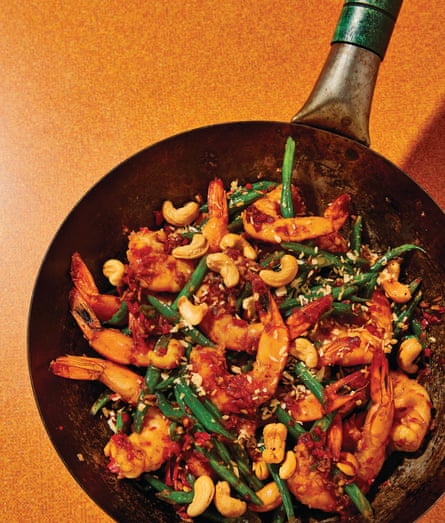
Tempeh tantanmen
I first tasted tantanmen, Japan’s take on Sichuan dandan noodles, during a dreamy, food-fuelled visit to Tokyo. As an avid lover of spicy foods, a friend had told me to seek out Gomaryu, a restaurant famous for its catchphrase, “tantanmen from hell”, with spice levels that catered for both the meek and the wildly insane. An ominous skull welcomed diners on the sign above the entrance.
A steaming bowl of pork tantanmen was laid before me, made with a conservative level two spiciness. What greeted me was a bowl of rich, nutty creaminess, laced with a surprisingly comfortable level of heat that warmed my insides. The portions were generous, with slippery noodles and a sesame broth that checked all the boxes.
Here, in place of pork, I’ve used pan-fried crumbled tempeh “rocks” – a technique I learned from friend and cookbook author Vanja van der Leeden. Cooked in this way, I don’t miss meat at all, and the crispy tempeh texture is a divine combination with the silky sesame broth.
In terms of pantry swaps, you could replace the tempeh with firm tofu, patted dry and crumbled. The choy sum can be replaced with any quick-cooking greens. Dried ramen noodles can be swapped for any kind of dried Asian noodles.
Prep and cooking time 30 mins
Serves 2
For the tempeh
200g tempeh, crumbled into small rocks
1 tbsp gochujang or doubanjiang
1 tbsp soy sauce
2 garlic cloves, peeled and thinly sliced
Flavourless oil (such as sunflower or grapeseed)
For the soup base
4 tbsp soy sauce
4 tbsp Japanese or Chinese sesame paste, or peanut butter (crunchy or smooth)
1 tbsp sesame oil
1½ tbsp chilli oil with crispy bits
1½ tbsp rice wine vinegar or cider vinegar
1½ tbsp white miso paste
2 tsp caster sugar
For the broth and garnish
2 eggs (optional)
100g choy sum, cut into large chunks
160g dried ramen
400ml unsweetened soy milk
400ml vegetable stock, preferably low salt
Marinate the crumbled tempeh rocks in the gochujang and soy sauce while you prepare everything else. Combine the soup base ingredients in a bowl and set aside.
Put the eggs in a medium saucepan and top with cold water until just submerged, with a large pinch of salt. Cover and bring to the boil, then reduce the heat and simmer for six minutes.
Remove the eggs from the pan and bring the water back to the boil. Run the eggs under cold water, then peel and cut in half. Set aside. Blanch the choy sum for two minutes in the boiling water, then drain and refresh in ice-cold water. Drain and set aside.
Prepare the ramen according to the packet instructions, then drain and stir with a little oil to prevent the noodles from sticking.
Meanwhile, place four tablespoons of oil and the garlic into a cold non-stick frying pan and bring to a medium-high heat. Fry the garlic slices until lightly golden, about two to three minutes, then remove them from the oil with a slotted spoon and set aside. Using the garlic oil in the pan, fry the tempeh on a high heat, stirring, until deeply golden and crispy, for about four to five minutes. Remove with a slotted spoon. Combine the tempeh rocks with the fried garlic and set aside.
Pour the soy milk and stock into the saucepan and gently warm through over a low heat. Do not allow the broth to boil, otherwise the mixture will split.
Divide the soup base between two large serving bowls, top with the noodles and soup broth, then garnish with the choy sum, tempeh rocks and eggs.
Sambal prawns with coconut and cashews

In this Indonesian-inspired recipe, you need only a handful of kitchen staples to create a spectacular dish with warmth and salty sweetness. Chillies and garlic form the sambal base, and are fried in oil until the chilli begins to caramelise and wrinkle. Taking a cue from the Indonesian vegetable dish sambal goreng buncis udang (fried sambal with beans and prawns), the green beans come to life, blistering in the pan and bathing in the rich, intensely flavoured sauce.
The textures are wonderful thanks to the flaky coconut and snappy cashews, but it’s the combination of kecap manis and gentle burn of the chilli that has my fork scraping the plate for more. Good quality frozen prawns are one of the greatest emergency ingredients, which is why I always keep a stash in my freezer.
To make this recipe vegan, omit the prawns and cook the rest of the recipe as is for a tasty side dish, or swap the prawns for tempeh or marinated firm tofu, patted dry and pan-fried until golden.
Prep and cooking time 25 mins
Serves 4
25g desiccated coconut
Flavourless cooking oil (such as sunflower or grapeseed) or coconut oil
20 medium raw prawns, peeled, tails on, defrosted if frozen
2 garlic cloves, peeled and crushed, or 2 tsp garlic paste
4 long red chillies, deseeded and finely diced
200g green beans, trimmed and cut into 5cm lengths diagonally
1 tbsp kecap manis
½ tsp coconut sugar or brown sugar
60g roasted salted cashews
Toast the coconut in a wok or large frying pan over a medium heat for about two minutes, shaking the pan frequently, until golden. Transfer the coconut to a plate.
Wipe out the pan and heat one tablespoon of oil. Add the prawns in a single layer and cook for one to two minutes each side, or until they are just cooked through. Remove and set aside on a plate lined with kitchen paper.
Heat another tablespoon of oil in the wok or pan, still over a medium heat. Add the garlic and chillies and cook, stirring continuously, for three to four minutes, until the chillies have softened and are starting to wrinkle.
after newsletter promotion
Add the green beans along with one tablespoon of water, the kecap manis, sugar and a large pinch of salt. Cook for another three minutes or so, stirring regularly, until the green beans are just cooked through with a crunchy bite.
Stir in most of the toasted coconut and cashews, reserving a little of each for garnish, and return the prawns to the pan. Toss everything together. Transfer to a serving plate and sprinkle with the remaining coconut and cashews.
Tamarind caramel brownies

My husband considers himself something of a brownie connoisseur, and he told me these were the best he’d ever eaten. I’ll let you be the judge of that (since he is blinded by the extreme bias of love), but what is clear is that tamarind’s sharpness takes flight in sweet desserts, and its sweetly sour profile offsets the richness of the caramel.
Served warm straight from the oven, this is a dessert brownie, the type you serve with a scoop of ice-cream. Served chilled or at room temperature, it’s the kind of pick-me-up, snacking brownie that you might nibble in the warm afternoon sunlight while sipping your last coffee of the day.
A little espresso powder enhances the spice and caramel notes of the chocolate, while the addition of macadamias is a nod to my Australian roots. You can substitute the macadamias with most nuts, such as walnuts or pecans.
To prevent your brownie mixture from splitting, make sure your eggs are at room temperature before adding them. You can freeze any leftovers for up to three months, but the brownies will last for about three to four days in an airtight container at room temperature, or up to a week in the fridge.
Prep and cooking time 1 hour
Makes 24 squares
100g macadamia nuts, roughly chopped
250g unsalted butter, cubed, plus extra for greasing
275g dark chocolate, preferably 70% cocoa, chopped into small pieces
250g caster sugar
¼ tsp flaky sea salt, plus extra for sprinkling
4 eggs, at room temperature, beaten
165g plain flour, sifted
1 tsp espresso powder, or instant coffee granules dissolved in 1 tsp hot water
For the tamarind caramel
50g golden syrup, or maple syrup
70g caster sugar
50ml double cream
20g unsalted butter
Large pinch of flaky sea salt
25ml tamarind paste
Preheat the oven to 200C/180C fan and set up the middle shelf for baking. Roast the macadamia nuts for six to eight minutes, or until golden brown, then remove and set aside.
To make the caramel, melt the golden syrup and sugar in a small heavy-based saucepan on a medium-low heat. Swirl the ingredients in the pan together, rather than stirring them. Once the sugar has dissolved and the caramel starts bubbling, continue cooking on a gentle simmer until it begins to bubble and foam, about three to five minutes in total.
Remove from the heat, then stir in the cream and butter until melted and combined. Add the salt and tamarind and stir well. Transfer to a wide bowl (this will help it cool faster), cover and leave to cool in the freezer for 20 minutes or in the fridge for around 30 minutes, until thick and gooey.
Grease and line a 20 x 30cm tin with baking parchment, ensuring there is some overhang of paper over the edges so you can easily lift the brownies out of the tin later.
Begin making the brownie batter. Gently melt the butter in a small saucepan. Once melted, remove from the heat, add the chocolate and leave to sit for two minutes, without stirring.
Stir the chocolate and butter together after two minutes; they should have melted together. Transfer to a large mixing bowl and combine with the sugar and salt.
After the chocolate has cooled down for two to three minutes, gradually add the room-temperature beaten eggs, a little at a time, mixing well in between additions by hand. Fold in the sifted flour, macadamia nuts and espresso powder (or instant coffee and water mixture) until well combined.
Pour half the brownie mixture into the prepared tin. Remove the tamarind caramel from the freezer or fridge and drizzle half of the caramel over the brownie mixture in the tin. Cover with the remaining brownie mixture and smooth the surface with a spatula. Drizzle with the remaining caramel, covering the surface as evenly as possible.
Using the end of a dessert spoon, gently ripple the caramel through the brownie mixture. To do so, dip the end of the spoon about one centimetre deep into the mixture and draw squiggly lines and figure-of-eight shapes all over the surface until the caramel is evenly distributed.
Bake for 25 to 30 minutes, or until cooked but gooey in the middle. Test with a skewer; there should still be a few moist crumbs on the skewer when inserted into the centre of the brownie, or a very slight smear of brown goo, but you don’t want wet batter. Sprinkle over a large pinch of sea salt while the brownie is still hot from the oven.
Leave in the tin until completely cool. Lift the brownie out of the tin using the baking parchment and transfer to a chopping board, then cut into squares and serve.

-
This is an edited extract of A Splash of Soy by Lara Lee, available now through Bloomsbury (RRP $45)


